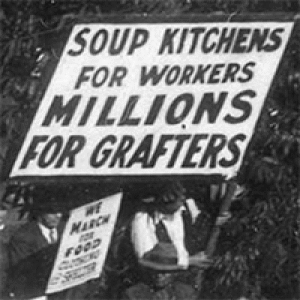
On this day in labor history, the year was 1930.
That was the day some 1300 labor radicals and Communist Party supporters assembled in Chicago to establish The National Unemployed Council.
That spring, Councils in major cities across the country held massive rallies for jobs and relief.
They were responding to near catastrophic conditions created by the Stock Market crash.
Delegates emerged from the founding convention with an organizational structure and demands for action.
These included unemployment insurance, cash and work relief, public works at union wages, free food for children of the unemployed and a moratorium on evictions.
Delegates acknowledged that African-Americans bore the worst of the unfolding Depression.
They worked to address racial discrimination as part of an integrated push for jobs and relief.
Councils were established throughout 46 states.
They were best known for massive demonstrations, hunger marches and rent strikes.
Councils mobilized hundreds, sometimes thousands quickly to march on city halls or relief offices when benefits were threatened.
They were also able to mobilize scores of supporters at a moment’s notice to stop evictions.
And in a unique move, councils often mobilized the unemployed to bolster picket lines during strikes.
This undercut employer attempts at recruitment of scabs.
By 1935, the National Unemployed Council merged with other socialist unemployed groupings, led by the Socialist Party and A.J. Muste, to form the Workers’ Alliance.
According to sociologist, Chad Alan Goldberg, the Workers Alliance worked to secure “more WPA jobs, higher wages for WPA workers, and application of new federal labor laws to the WPA.”
Goldberg attributes their demise by 1941 to a combination of factors, including the rise of a powerful anti-labor coalition of Republicans and Southern Democrats, red baiting and internal political conflicts.
More Episodes
 2024-02-24
2024-02-24
 2024-02-20
2024-02-20
 2024-02-18
2024-02-18
 2024-02-17
2024-02-17
 2024-02-17
2024-02-17
 2024-02-13
2024-02-13
 2024-02-10
2024-02-10
 2024-02-07
2024-02-07
 2024-02-07
2024-02-07
 2024-02-07
2024-02-07
Create your
podcast in
minutes
- Full-featured podcast site
- Unlimited storage and bandwidth
- Comprehensive podcast stats
- Distribute to Apple Podcasts, Spotify, and more
- Make money with your podcast
It is Free
- Privacy Policy
- Cookie Policy
- Terms of Use
- Consent Preferences
- Copyright © 2015-2024 Podbean.com




